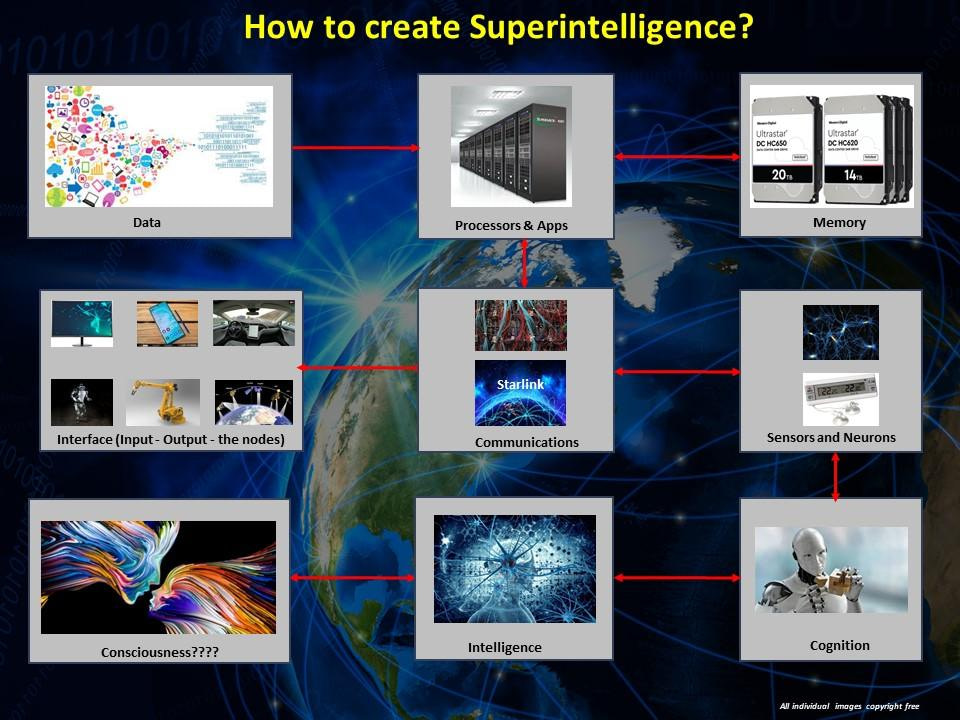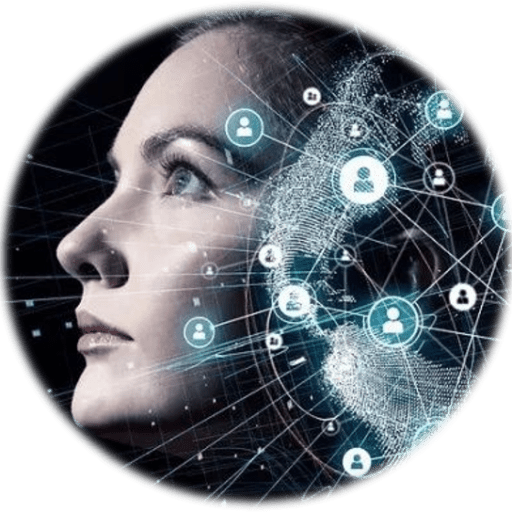In order to understand how Superintelligence may interact with humans in the future, we need to know what it might be made of and what it might look like. Let me start with the first aspect. For the last few years we have already been exploring the ways, in which we could build such a superintelligent agent. The scientists working in that area come from different disciplines. It is probably the most interdisciplinary ‘project’ that Humanity has ever contemplated. We have started the creation of something that one day may become a new species.
So, how could we create Superintelligence? All ingredients to create it are already here, apart from cognition and (eventually) consciousness. Below is your shopping list. While the ingredients are real, the projected numbers are just an approximation of what might be available in about 10 years, when we may produce, what I call the Immature Superintelligence. I use the period of 10 years as a kind of a threshold. That is based on various forecasts, but mainly on the most well-known – Ray Kurzweil’s prediction. He says that by 2029 we shall have computers, which will pass the Turing test, making it impossible to tell whether the ‘person’ you are talking with, hidden behind a screen, is a human or a machine (some scientist believe it has already happened). If we apply the so-called Moore’s law, which predicts that computing power doubles every 18 months, then it is possible to calculate that all computer-related processes will improve by at least 100 times in 10 years, which means a powerful home computer will have the capacity far exceeding the power of a human brain. To achieve that we will need the following components (most the data is from 2019 or earlier and every 18 months the performance or capacity of individual items will double):
- Data. We will need an absolute mass of digitised data like text, pictures, videos or sound. Goggle’s database is currently about 10 exabytes (1019) bytes. By 2030 it will probably reach hundreds of zettabytes (1021) bytes. Will that be enough for Immature Superintelligence?
- Processors. In this context they are super gigantic computers with immense power to process super large-scale databases. The fastest one, Summit, is currently at Oak Ridge National Lab in the USA, which can perform 200 quadrillion calculations per second (2*1017). In 10 years, the fastest computer, might be processing even 1020 times more information, which may be the very bottom edge of what is needed to have a fledgling Superintelligence. However, since quantum computers, will be billions of times faster for some calculations than a conventional computer, this looks as a very conservative estimate. That has already happened. Google’s Sycamore quantum computer consistently performed certain mathematical calculations in 200 seconds, which would have taken the Summit computer 10,000 years. This is what exponential change means. Even during the course of writing this text, some predictions expected to materialize in a decade, have become a fact today.
- Memory. We need plenty of this, at least xenottabytes, i.e. 1,000 more than the data itself, if we include the backup.
- Cables and communications infrastructure. Today we already have fibre optics, laser, radio waves, 5G for smart phones and WI-FI, which with further improvements in speed could be good enough for connecting various part of this immense web, including the satellites. By 2024, Elon Musk’s Starlink constellation of 12,000 satellites will provide access to the Internet from any part of the globe, for the price competitive with traditional Internet Services Providers or mobile operators.
- Interfaces. These are devices for the input and output of information, sometimes also called nodes. We already have them today. These can be computer keyboards, screens, printers, scanners, smartphones, industrial robots, Tesla cars, satellites, humanoids such as Sophia or Erica, and finally – holograms, which might probably be the preferred interface for the future Superintelligence.
- Sensors and Neurons. Sensors feeding information on the state of objects or systems, like temperature or pressure. There are thousands of various types of mostly digital devices in use today. Neurons are also a type of a sensor. They react probabilistically rather than in a binary way. We have already built artificial neurons but they are too big and that’s why their density is far inadequate. However, quantum computing will enable the building of super microscopic neurons in the next few years. IBM has already produced neuromorphic neurons binding to biological neuron.
- Cognition. Computers can now recognize faces and the environment, e.g. Tesla cars can differentiate between various types of objects. Our smartphones can speak clearly with superb elocution skills in over 60 languages using Natural Language Processing (NLP) such as GPT-3 transformers, or similar applications used by Watson, Sophia, Alexa, Google Assistant or Bixby. However, these smartphones have no clue what they are talking about. So, today we have made some progress but there is still a long way to go to reach the level of human cognition.
- Intelligence. This is really about the algorithms – making sense of relations between data, finding patterns and drawing conclusions that enable actions. We are nowhere near even to the level of intelligence of a mouse yet. That, combined with a human level cognition which we will need, is the biggest barrier and that’s why we may not have a mature Superintelligence for a few decades yet.
- Consciousness. Most AI specialists believe it is not a necessary condition for Superintelligence to have. Some may think, it would be nice to have. Others fear about the consequences of dealing with a conscious being, which will also be millions of times more intelligent than us. We even do not know whether consciousness is possible in non-biological entities. If it is, then it might happen because Superintelligence discovers itself some algorithms and very peculiar neural connections that would make it first self-aware and then fully conscious.

All these elements listed above, apart from cognitive function and consciousness are available today and are connected and presented to us via Google and Internet with its communication network. But the Internet is mostly just an infrastructure. What really matters are the resources and capabilities. This is the ‘soft’ side of the Internet, where the browser, like Google is the king supported by Facebook, GPS and other information processing and communication applications. This is the ‘intelligence’ that we use every day. You may not realize that Google can right now answer almost any question, translate nearly instantaneously any text into most modern languages, guide us using the satellite navigation to any part of the globe, provide access to trillions of pictures, videos or documents in an instant from any point of the planet, 24 hours a day.
However, it will take another 10 years, or so, to arrive at the artificial intelligence that would have a combined capacity of about 100 human brains. Should it be combined as a seamless cognitive agent with senses (neurons), we would have a very slowly reacting prototype of Superintelligence. I call this lowest level of Superintelligence, the Immature Superintelligence. By then it will already have a reasonable sense of cognition but still incomparable with humans’ capability. To achieve that, it will take approximately 20 more years, so that by about 2050 we shall have a mature cognitive Superintelligence with the combined capacity of at least 1 billion human brains. What it may still lack is consciousness. However, some scientists believe consciousness is irrelevant for an intelligent agent for making decisions.

Comments